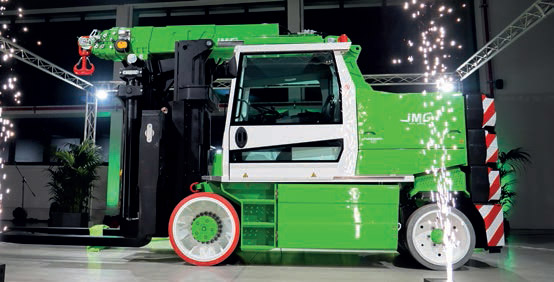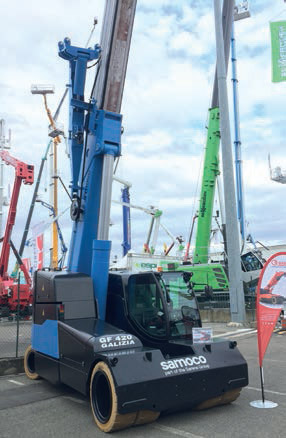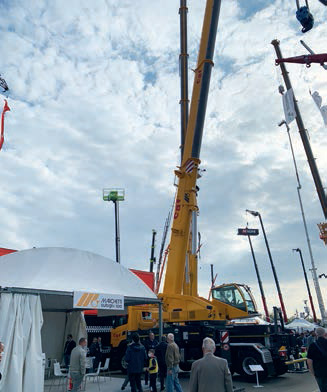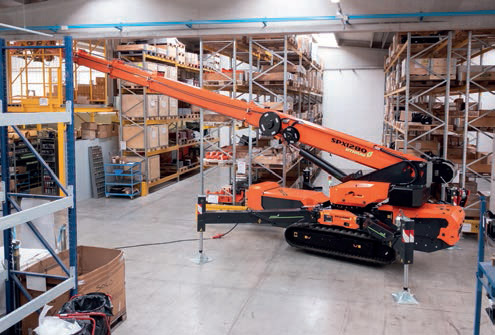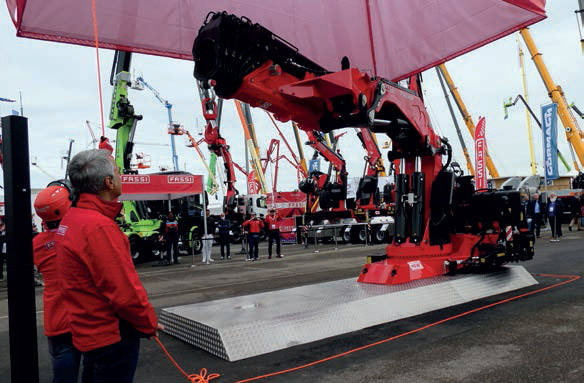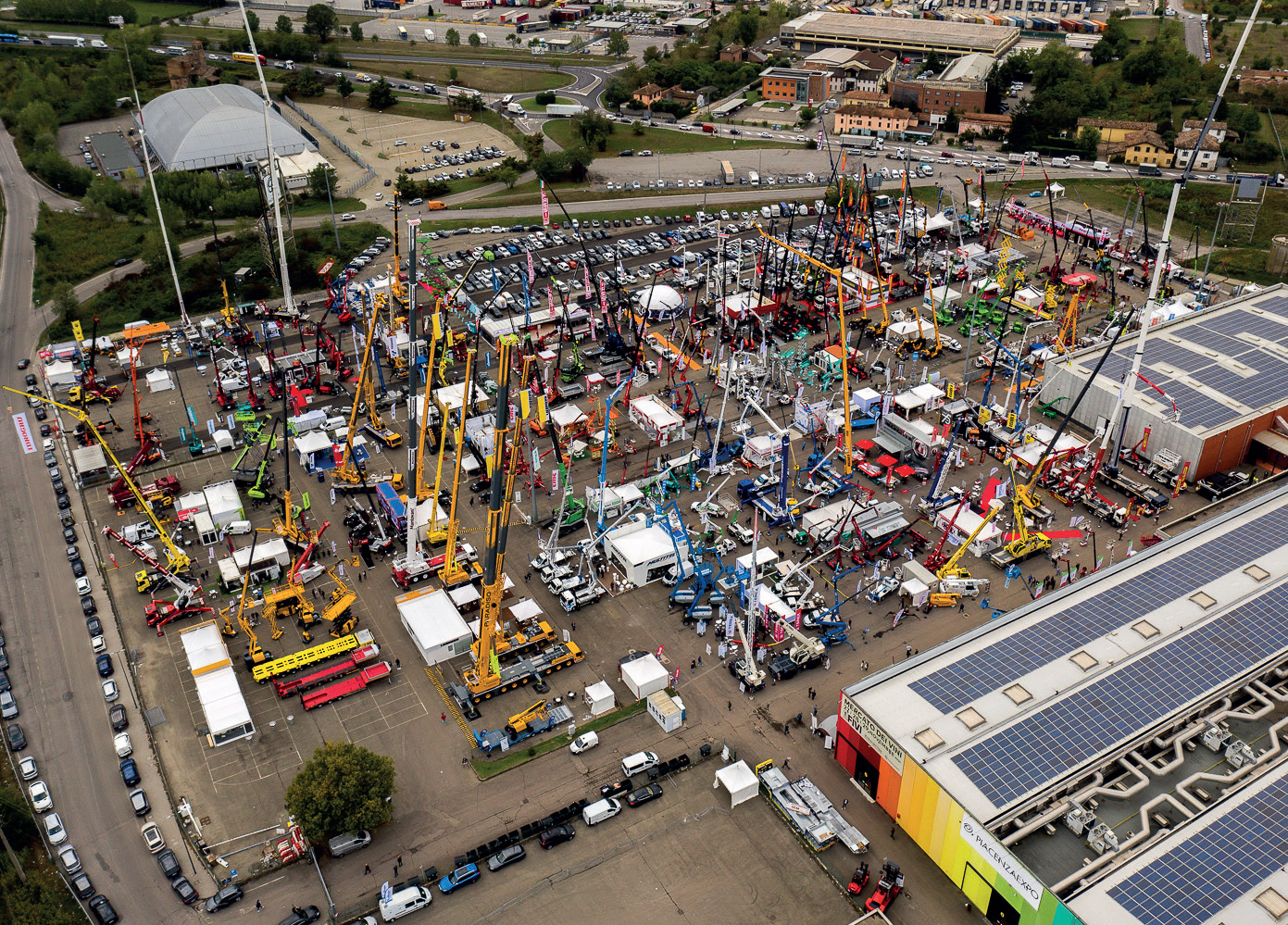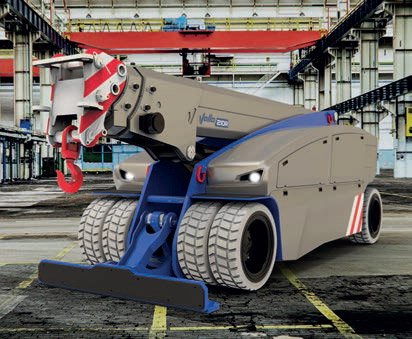Italy goes GIS
29 November 2021The GIS crane exhibition, held in Piacenza from 7–9 October, was a welcome stage for manufacturers for whom the pandemic has long denied the opportunity to publicly display their latest products. Italian manufacturers made the most of it. Julian Champkin reports.
Italy is blessed with a multitude of crane makers. Many of them are home grown; some are from overseas, such as Zoomlion, which is building a new facility at Solferino, or Manitowoc, which has been producing Grove cranes in Piedmont since 2018. For all of them the GIS show was a longed-for opportunity to show their wares. It has been almost universally described as a real success and companies invested effort and resources to showcase their latest products.
Fassi Among them was Fassi, who arranged a press conference to announce that its FX-Link system for unified control of truck cranes is now also available for machines mounted on Iveco trucks. FX-Link optimises connectivity between the crane and truck. It allows vehicle functions to be controlled from the crane cab, as well as vice versa: the status of the crane can be monitored from the truck dashboard. All of this translates, Fassi says, into simplification of the electrical connections between crane and truck and an increase in truck functions that can be managed via the crane’s radio controller, where information relating to the vehicle can also be displayed.
Using the CAN-BUS connection, the Fassi FX-Link system interprets and integrates the messages coming from the vehicle, encoding, processing and transforming them, and making them available on the crane radio controller. This lets the operator monitor and control various truck functions via the radio controller itself. The operator can switch the vehicle on and off, adjust its engine speed, switch headlights, hazards and indicators on and off, activate the horn, and check fuel levels, battery voltage, axle loads, the status of the PTO, the handbrake, and the air suspensions, and even the truck axle configuration.
The FX-Link application requires cranes equipped with Fassi V7 radio controllers, as is available for Iveco S-way, T-Way and -Way models.
Locatelli
“GIS has been the first live event since Covid-19 first struck, and the feelings are very favourable.” So says Michele Mortarino, sales manager for Locatelli. “We presented our best seller model, the GRIL 55.50, a medium duty rough terrain crane.” Further details are in the rough terrain.
The company has also re-entered the truck crane market after an absence of some years. Its TCL 40.35, on a three-axle carrier by Mercedes-Benz and with a four-element telescopic boom, has a 35t capacity; the larger TCL 55.50, on a four-axle carrier, can lift 50 tonnes at three metres.
JMG
At GIS JMG took a double stand to showcase a wide range of its pick-and-carry models. It also held an ad hoc event on the evening of 8 October for the official presentation of its new fully electric forklift crane MC250.09FL.
There were two new products, the MC22500RE articulated slewing crane and the new MC45S, which were launched on the market at the GIS show.
The MC225000RE features a hydraulically rotating arm on a continuous and unlimited 360-degree rotating turret. It is fully radio-controlled, including the independent front and rear stabilizers. The crane itself has a small footprint of 1,850 mm wide by 4,150 mm long, and is 2,100 mm high, to allow easy access to internal working areas; when working, however, its stabilisers can cover up to 3,925 × 3,030 mm. In this arrangement the crane arm can operate with a maximum outreach of 11.56 metres, which an optional jib increases to 20 metres. The total weight is 12500 kg.
The MC100S, MC130S, MC180S, MC50000RE, MC30S and LIGE60 electric pick-and-carry cranes were all there. None of these were new but all have undergone a thorough makeover in the past 18 months.
Marchetti
A GIS Marchetti displayed is recent truckmounted crane: the 180 tonne capacity MCK 180. The superstructure is operated through the truck’s PTO and can be mounted on most truck brands currently on the market: Iveco, Volvo, MAN and Mercedes are all suggested. Three sections of the six-section semi-round telescopic boom are synchronised, two are independent and hydraulically operated.
Total boom height from the ground is 40 metres, or 53 metres with the lattice extension. The crane is supplied with a 80 tonne hook block and a counterweight of 11.6 tonnes in three pieces.
Also featured by Marchetti were two of its crawler cranes: the CW 70.42L Sherpa, and the smaller CW 25.3 – appropriately named the Sherpina. The Sherpina is compact – it can be hauled, says the company, without removing anything and has a low gross weight of 25.5 tonnes for easy relocation. The undercarriage has variable gauge crawlers that range from 2500 mm retracted to 3900 mm extended; It has a 17 tonne pick-and-carry capacity, a reduced tail-swing radius, three tonnes of counterweight, and a maximum tip height (with a folding jib) of 36 metres. A hydraulically-operated tilting cab is to provide improved visibility.
Its big sister, the Sherpa, has a 70 tonne capacity, an octagonal five-section boom which, with the folding lattice extension, can reach 58.5 metres. It is 2.98 metres wide when the crawlers are retracted and, again, it can be hauled without removing anything: tracks, counterweight and outriggers remain fitted to the machine, which has a gross weight of 56.5 tonnes.
F.Lli Ferrari
F.lli Ferrari’s New Age range of no fewer than 40 knuckleboom cranes has been joined by the 9445C, which was presented for the first time at GIS. F.lli’s partner Hyva was also showing at its stand. The New Age cranes span from 9tm up to the 66tm class.
The range includes the short boom SC series, from 9tm to 26tm; these cranes have a shorter second boom for higher lifting capacity and better performance on tall loads on close lifts and are optimised to use with attachments and short trucks. The D series has a telescopic boom for applications such as car recovery.
The wide slewing angle of 425 degrees on its cranes is, F.lli Ferrari says, best in class for medium sized cranes and reduces cycle time and improves efficiency. The 9000 series (23 to 66tm) features endless slewing.
The company is proud of its 3D CAD design system and its use of FEM (Finite Element method) in the design stage to analyse crane structure and loading conditions to optimise strength-to-weight ratios.
Its cranes now feature dynamic load diagrams, a feature it claims as a first and only for truck-mounted knucklebooms. It allows the driver to verify in advance the crane’s lifting capacity based on the stability of the truck. The operator can select the load weight and the system calculates the stability in all directions around the truck, taking the positions of the stabilisers into account. A graphic display shows the actual boom slewing position and the outreach available for the selected load. The system, it says, optimises stabilisation and makes crane operation safer and more efficient. F.LLi Ferrari’s ‘Magic Touch’ system is also fitted: it allows automatic folding and unfolding of the booms to transport and working positions at the touch of a single button.
Jekko
Jekko were displaying its two ranges of telescopic mini-cranes: the SPX and JF. Its best-seller is the 3.2 tonne SPX532 mini spidercrane.
As with other models in the range it can mount a diesel engine or lithium batteries and an electric engine for indoor working.
Its spider stabilisers can double-articulate to five different positions. The crawler tracks can be raised or lowered relative to each other, allowing the crane to stand vertically even on surfaces that slope up to 45 degrees. A one-tonne hydraulic jib can be rested either on the column, on the ground, or under the main boom, and the crane can perform 400 kg pick-and-carry operations.
The SPX650, first presented in July 2020, is a five-tonne minicrane; the SPX1280, has a lifting capacity of eight tonnes. Jekko’s tools catalogue includes the JVL450 and JVL600 vacuum lifters, the JVM800R manipulators for glass and slates, and the JIB500GR for lifting iron bars.
Jekko also presented the MPK10, its new one-tonne mini-picker that expands its glass-handling range alongside its established MPK06
Valla
Manitex Valla, Piacenza-based Italian subsidiary of Manitex International, were showing its V 210 R, radio- or cab-controlled compact electric mobile crane.
This is a new addition to the Valla pickand- carry range for handling indoor loads. Six non-marking-tyred wheels, as well as fume-free electric power, are designed for that purpose; with a payload of up to 21 tonnes it is at the heavy end of its electric pick-and-carry range. Despite that, it maintains compact dimensions: a maximum width of just 1980 mm, and 2000 mm of height; a turning radius of 4100 mm gives an optimal ratio of payload to size so that it can pass through industrial-sized doors and work in areas with space limitations. It can lift to a height of 12.5 metres and has a horizontal reach of 8.2 metres. Its octagonal-section boom has three direct-control telescopic elements with double cylinders; a three-position tilting head is fitted as standard. The battery is 96V, 1.050Ah with automatic top-up and a high frequency charger on board.
The crane can be configured in three different modes: radio controlled, cab controlled, or cab+ radio. It has a 220 bar hydraulic system, 180 degree rear steering, and electro-hydraulic brakes; options such as hydraulic winch, folding jib, and 10 tonne forks are available.
The crane has Valla’s exclusive and patented Shield – Stabilizer, which has a dual function: it protects the wheels from the load during pick-and-carry operations, and it ensures better stability and boosts lifting capacity for safer and better handing during lift and placement of the load.
The three removable counterweights weigh 2.5 tonnes apiece, but since the total weight of the crane is 23.5 tonnes (hook only setup) it can be transported in full working configuration on most low-bed trailers without the need to disassemble the counterweight or send it separately for re-assembly on site.
Effer
Effer showed its Effer 215 knuckleboom. With a lifting capacity of 10 to 30 tm it fits into the mediumsized range. The model on display was equipped with stabilisers with increased hydraulic output and work lights that can be activated by remote control.
The jib can work at a positive angle to make life easier for those working inside buildings or on lower floors.
The truck can be positioned outside and still deliver its load to inside areas or basements.
Galizia
Galizia has been in business for more than 120 years in Asti in Italy’s northern engineering homeland of Piedmont. It too specialises in the crane that Italy has made its own: the compact pick-and carry. Its G20 has been a reference model in the industry, Galizia says, for more than a decade in applications such as glazing and industrial maintenance, and has been used in the construction of skyscrapers worldwide.
At GIS it was showing its GF180 and the 42 tonne capacity GF420 – the most compact pick-and- carry cranes in their capacity range, says the company.
The GF420 is its latest model, launched this year. Galizia says it synthesises all the innovations it has developed over the past 15 years, including radio remote control and a dual motor frontwheel drive system with counter-rotation. This means the front wheels can turn independently of each other, and even in different directions, one clockwise, the other anti-clockwise; this gives the four-wheel crane the manoeuvrability and tight turning circle of a three-wheeler while keeping the stability of four wheels. It has two ‘fifth wheels’ at the rear, and a variable length chassis, giving even tighter turning. It also has the option of a cab. “We like to say that if you buy a Galizia you don't have to make a compromise, because a 'no-cab pick-and carry' is the most compact crane there is – and the Galizia is exactly that, but with a cab,” says general manager Fabio Vercelli. “To have or not to have the cab is a customer choice not related to the dimensions.” There are indeed compact, at 2.09m wide and 4.6m long (which with the variable length chassis extended becomes 5.6m).
“All Galizia models are known for their power but also for their smoothness of traction,” Vercelli adds. “We have a unique traction system that permits precise crane movement without any ‘comeback’ of the crane during steering with load after traction release.” Samoco, part of the Sarens group, has chosen the GF420 for its performance and dimensional characteristics. “We are very glad to start this new co-operation with one of the leaders in lifting companies worldwide.”

